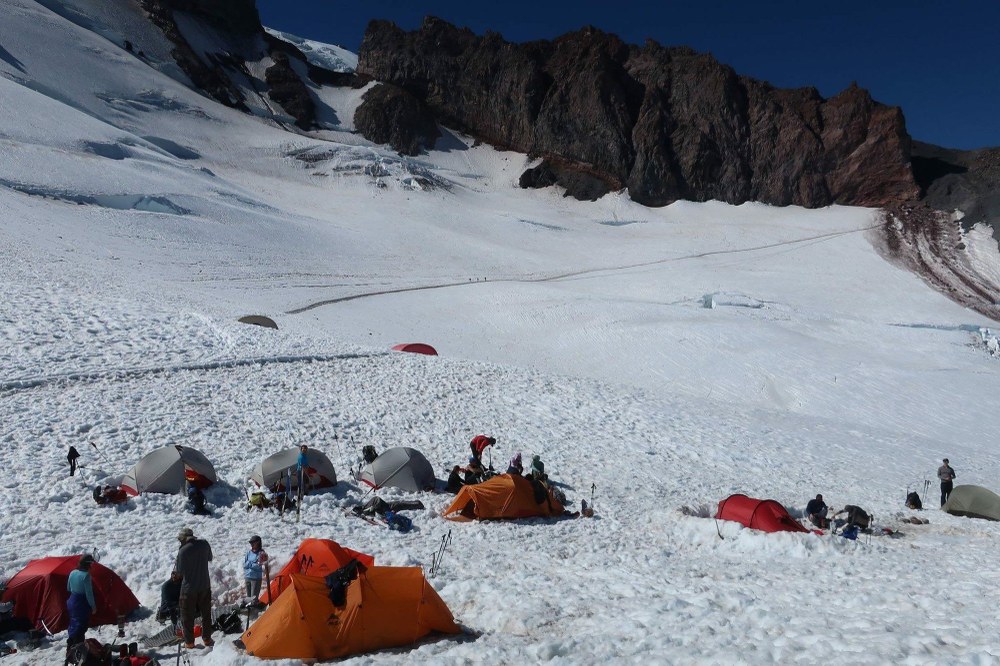
Decision-making as a leader is hard and inevitable. There are times when you are forced to face these epic inner battles rivaling Middle-Earth wars and can choose to retreat or be defeated. Retreat equates to loss of pride, but you live to die another day. Defeat may bring you to the ultimate destination but may also ensure delicious victory in the clenching teeth of the Sauron of Summit Fever.
Attaining the summit only constitutes half the climb. The absolute hardest part of a climb is the pending descent...when you’re tired, you can become complacent and think the difficulties are behind you, especially coming off the high-flying elation of achieving your goal.
We had another 40 minutes until our turnaround time. We were faced with two choices: explore and ascend, or retreat and descend. That 40 minutes of exploration would have inevitably extended into 2.5 hours, as it would have taken that long, at our pace and with all the other parties on the mountain, to reach the summit. Any extra hours would have almost guaranteed adverse conditions on the descent, despite the bluebird skies. If the temperatures began to rise as predicted, we were facing inevitable threat of rock and icefall heading back to camp.
So I stuck to my turnaround time, as unpopular as the decision may have been, not only for me, but for my five remaining partners, divided between two rope teams. I waffled, almost succumbing to the pressure to push on...the intense feeling of gratification I would feel, attaining the summit and enabling the others to reach their goal as well. I paused below what looked to be the crux of the climb. We were so close. 40 minutes until turnaround time. I thought about how far we had come. Thoughts whirled inside my head. We might be able to...we may reach the crater at the very least. No. We could not even make the crater rim. We were so far away. Funny how 1200’ seems like such a short distance but becomes a significant and challenging slog at altitude.
I know in my heart of hearts that if I extended my turnaround time because we were “so close”, that “so close” would become “even closer”, and “even closer” would have translated to “almost there”, and “almost there” would have translated to “we’ve made it!”; and “we’ve made it!” would have come with not just a victory, but a potentially hefty price to pay for this personal achievement.
The radio crackled.Our primary leader had descended selflessly from 11,700 to camp, taking two climbers down who were exhibiting symptoms of Acute Mountain Sickness. I relayed our position. He called up to me, jokingly, Are you bottlenecked at the Hillary Step? From his vantage point he saw an ant line of climbers descending from the summit. I thought about where we were, where we were about to be, and how difficult it would be after ascending only a hundred more vertical feet to turn two rope teams around easily, let alone efficiently.
I vacillated between the seemingly right and the imperceptibly wrong, and came up indecisive. A heartbeat passed, or three, or three hundred, and I made the call to turn around. A glorious day: bluebird skies, sunshine, almost-perfect snow conditions, minimal crevasses on our route so far, and only 1200 ft from the summit. I single-handedly ruined our summit bid. I broke my own heart saying the words, “We need to descend, let’s turn around.” Tears pricked at my eyes, knowing we had come this far, but knew would need time we just didn’t have to be able to descend the mountain safely.
I made the right decision. I felt the need for validation of this decision, given the picture-perfect day and the conditions, but I truly didn’t need validation. The only thing that mattered on the mountain that day is that I made a conscious choice based on our plan, our team, other people and approaching conditions...stuck to it...and we all stayed safe to climb another day.
Add a comment
Log in to add comments.Thanks for sharing. In Everett's annual orientation for aspiring scrambling leaders, I convey that turning back, especially when the summit is feasible, is typically the most difficult decision a leader will face. I emphasize for leaders to have an understanding of the turnaround time, and the reason for the turnaround time, before they post the trip. With such knowledge, a leader can have the best confidence in deciding whether to retreat, or to continue (if conditions are different than assumed when the turnaround time was first calculated), and can separate that decision from the desires & goals of the group. Easier said than done.
Hurrah, Liana. You've modeled making a personally, but necessary, leadership decision. Thanks for going public. We so often get sucked into "best case" rather some something closer to "worst case" decision making.
 Liana Robertshaw
Liana Robertshaw